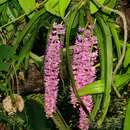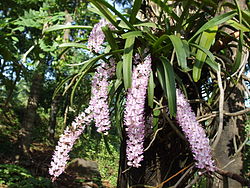fi
nimet breadcrumb-navigoinnissa


Ринхостилис (латин Rhynchostylis) – Орхидея котырса быдмӧг увтыр. Сійӧ быдмӧ Азияын.
Ринхостилис (лат. Rhynchostylis) – Орхидея котырись (Orchidaceae) быдмас увтыр. Ринхостилис увтырӧ пырӧны 6 вид. Ринхостилис пантасьӧ Азияын.
Ринхостилис (лат. Rhynchostylis) – Орхидной будосъёс (Orchidaceae) семьяысь Азилэн сяськаё будос. Дуннеын тодмо ог 6 пӧртэм.
Ринхостилис (лат. Rhynchostylis) – Орхидной будосъёс (Orchidaceae) семьяысь Азилэн сяськаё будос. Дуннеын тодмо ог 6 пӧртэм.
Ринхостилис (латин Rhynchostylis) – Орхидея котырса быдмӧг увтыр. Сійӧ быдмӧ Азияын.
Ринхостилис (лат. Rhynchostylis) – Орхидея котырись (Orchidaceae) быдмас увтыр. Ринхостилис увтырӧ пырӧны 6 вид. Ринхостилис пантасьӧ Азияын.
Rhynchostylis (abbreviated Rhy in the horticultural trade) is a genus in the orchid family (Orchidaceae), closely allied to the genus Vanda (from which it differs in the one-lobed lip of the flower) and comprising four currently accepted species native to the Indian Subcontinent, China, Indochina, Malaysia, Indonesia and the Philippines.[1][2] The name consists of a compound of two Greek elements : rhynchos 'beak' and stylis 'column' – in reference to the very broad, fleshy column of the flower. The flowers are borne in dense racemes and are noted for their intense, spicy fragrance. Although lacking in pseudobulbs, the plants have leathery leaves that are drought-resistant. These orchids grow naturally in warm, moist, shaded tropical areas and will thrive in cultivation if given consistent warmth, uniform moisture and bright, but indirect light. Hobbyists wanting to grow them will need a warm, humid growing environment with gentle air movement. They can be grown in pots, but are better grown in baskets, owing to the extreme fleshiness of their roots. Their unusually fragrant blooms often appear in the slightly cooler winter months.[3]
Despite being in the Vanda tribe, they are very different from vandas. They grow more slowly, their roots are more fragile, and almost any direct sun will harm them. However, they are typically grown with no potting mix on slat baskets or mounted in the same way as vandas.[4] [5]
The genus possesses valuable medicinal properties meriting in-depth pharmacological investigation, including antispasmodic and antiseptic activity.[6] Several species have been found to contain alkaloids.[7]
The Subtribe was changed from Sarcanthinae (Benth, 1881) to Aeridinae (Pfitzer, 1887) in 1972.[8][9]
As of February 2022, five species are recognized though many others have been proposed:[1]
Rhynchostylis (abbreviated Rhy in the horticultural trade) is a genus in the orchid family (Orchidaceae), closely allied to the genus Vanda (from which it differs in the one-lobed lip of the flower) and comprising four currently accepted species native to the Indian Subcontinent, China, Indochina, Malaysia, Indonesia and the Philippines. The name consists of a compound of two Greek elements : rhynchos 'beak' and stylis 'column' – in reference to the very broad, fleshy column of the flower. The flowers are borne in dense racemes and are noted for their intense, spicy fragrance. Although lacking in pseudobulbs, the plants have leathery leaves that are drought-resistant. These orchids grow naturally in warm, moist, shaded tropical areas and will thrive in cultivation if given consistent warmth, uniform moisture and bright, but indirect light. Hobbyists wanting to grow them will need a warm, humid growing environment with gentle air movement. They can be grown in pots, but are better grown in baskets, owing to the extreme fleshiness of their roots. Their unusually fragrant blooms often appear in the slightly cooler winter months.
Despite being in the Vanda tribe, they are very different from vandas. They grow more slowly, their roots are more fragile, and almost any direct sun will harm them. However, they are typically grown with no potting mix on slat baskets or mounted in the same way as vandas.
The genus possesses valuable medicinal properties meriting in-depth pharmacological investigation, including antispasmodic and antiseptic activity. Several species have been found to contain alkaloids.
The Subtribe was changed from Sarcanthinae (Benth, 1881) to Aeridinae (Pfitzer, 1887) in 1972.
Rhynchostylis, (abreviado Rhy), es un género de orquídeas del género (Orchidaceae), comprende 3 especies endémicas de India, Malasia, Indonesia y las Filipinas.[1][2]
Estas orquídeas crecen naturalmente en áreas cálidas, húmedas y tropicales sombreadas. Sus flores fragantes aparecen con frecuencia en los meses de invierno.
A pesar de estar en la tribu Vandeae, son muy diferentes a Vanda. Crecen más lentamente, sus raíces son más frágiles, y casi cualquier luz directa del sol les hará daño. Sin embargo, se cultivan normalmente sin mezcla de tierra en cestas de listones o montadas como las Vandas.[3] [4]
La Subtribu fue cambiado de Sarcanthinae (Benth, 1881) a Aeridinae (Pfitzer, 1887) en 1972.[5][6]
El género fue descrito por Carl Ludwig Blume y publicado en Bijdragen tot de flora van Nederlandsch Indië 7: 285, 434. 1825.[7]
Rhynchostylis, (abreviado Rhy), es un género de orquídeas del género (Orchidaceae), comprende 3 especies endémicas de India, Malasia, Indonesia y las Filipinas.
Estas orquídeas crecen naturalmente en áreas cálidas, húmedas y tropicales sombreadas. Sus flores fragantes aparecen con frecuencia en los meses de invierno.
A pesar de estar en la tribu Vandeae, son muy diferentes a Vanda. Crecen más lentamente, sus raíces son más frágiles, y casi cualquier luz directa del sol les hará daño. Sin embargo, se cultivan normalmente sin mezcla de tierra en cestas de listones o montadas como las Vandas.
La Subtribu fue cambiado de Sarcanthinae (Benth, 1881) a Aeridinae (Pfitzer, 1887) en 1972.
Rhynchostylis est un genre de la famille des Orchidaceae , sous-famille des Epidendroideae comptant trois[1] espèces d'orchidées épiphytes d'Asie du Sud-Est.
Inde, Malaisie, Philippines
Rhynchostylis est un genre de la famille des Orchidaceae , sous-famille des Epidendroideae comptant trois espèces d'orchidées épiphytes d'Asie du Sud-Est.
Rhynchostylis Blume, 1825 è un genere di orchidee epifite diffuse nell'Asia sud-orientale.[1]
Il nome deriva dal greco rhynchos (rostro, becco) e stylis (colonna), in riferimento al ginostemio a forma di becco tipico del genere.[2]
Sono orchidee epifite dallo sviluppo monopodiale. L'infiorescenza racemica è pendula e ricca di piccoli fiori profumati. Il genere è strettamente correlato a Vanda, dal quale differisce per il labello monolobato.
Il genere è presente in India, Sri Lanka, Nepal, Himalaya, Bangladesh, Myanmar, Cina meridionale, Malaysia, Thailandia, Laos, Cambogia, Vietnam, isole Andamane e Nicobare, Borneo, Sumatra, Giava e Filippine.[1]
Il genere Rhynchostylis comprende cinque specie:[1]
Può dare luogo al seguente ibrido intergenerico:[3]
Rhynchostylis é um género botânico pertencente à família das orquídeas (Orchidaceae).
Chi Rhynchostylis, viết tắt là Rhy trong ngành kinh doanh cây cảnh, là một thành viên của họ Lan, bao gồm 6 loài đặc hữu to Ấn Độ, Malaysia, Indonesia và Philippines.
钻喙兰属(学名:Rhynchostylis)是兰科下的一个属,为附生兰。该属共有约15种,分布于亚洲热带地区。[1]

リンコスティリス属 Rhynchostylis は、ラン科植物の1群。ヒスイラン属に似て、花は多数を穂状に密につける。洋ランとして栽培され、近縁属との交配も行われている。
常緑の多年生草本で着生植物[1]。全体にヒスイラン属に似ているが、茎は長く伸びず、葉は間を置かずに密接して出る。葉は肉質で硬く、線形で細長く、先端は2つに裂け、左右の先端の大きさは異なる。
花茎は葉腋から出て長く伸び、直立するか弓状に垂れ、その先の方に多数の花を密につける。花は肉厚で香りを持つ。萼片と側花弁は離れて生じ、長楕円から倒卵形で、身弁は蕊柱の基部について単独か少し三裂し、短い距がある。花粉塊は蝋質で2個[2]。花色は白地に赤や紫の斑点が入るものが多い[3]。
学名はギリシャ語で「嘴」を意味する Rhynchos と「柱」(stylos)、あるいは「小さな柱」 (stylis) の合成になるもので、これはタイプ種である R. retusa の蕊柱がくちばし状であることによる。英名は花穂が太い棒状になって垂れる姿からフォックステールオーキッド(狐の尾のラン)という[4]。
インドからマレー半島、インドネシアとフィリピンにかけて、4種が分布している。樹上に着生する。
以下の種が知られる[5]。
洋ランとして栽培される。略称は Rhy. である。個々の花は大きくないが、多数が集まって咲くので目を引き、また香りもよい。ただし一般の花屋で見かけるほどには普及していない。性質はヒスイラン属に近く、やはり根の通気を求めるため、バスケットで栽培する。更により湿度と通気を求める性質が強い[6]。
原種も栽培されるが、交配も行われている。また、近縁属との属間交配も行われており、以下のような人工属がある[7]。特にリンコバンダはバンダ系の属間交配ものでアスコケンダ(Ascocenda:ヒスイラン属とアスコケントラム Ascocentrum の交配)に次いで人気が高い[8]。